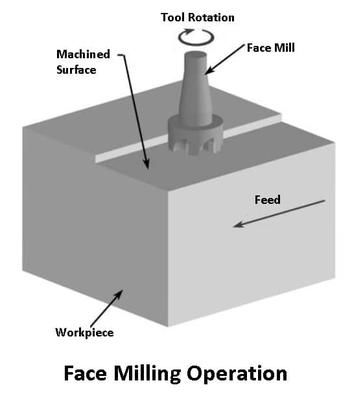
Introduction: What is Face Milling?
Face milling is a machining process used to produce flat surfaces, contours, grooves, and other features on the workpiece, typically utilizing a rotating cutting tool. This type of milling is distinct because the cutting action takes place on the surface of the workpiece, with the cutting edges of the tool acting perpendicular to the workpiece surface. Face Milling Operations are essential in a wide range of industries, from aerospace and automotive to electronics and manufacturing, as they allow for precise, high-quality surface finishes and dimensional accuracy.
In this article, we will explore the details of face milling operations, including how they are performed, the types of face milling techniques, their applications, advantages, and challenges, as well as the latest advancements in the field. Whether you’re a machinist, manufacturer, or industry professional, understanding face milling operations is crucial for optimizing machining processes and achieving desired results.
What is the Difference Between Face Milling and Other Milling Operations?
Before diving deeper into the specifics of face milling, it’s helpful to understand how it differs from other common milling techniques. In milling, the cutting tool rotates around the workpiece to remove material. While face milling is focused on machining flat surfaces, there are other types of milling operations with different goals and cutting actions, including:
-
End Milling: In this operation, the cutting tool cuts along the axis of the workpiece. It is often used for creating slots, grooves, or precise contours along the edges of a part.
-
Slot Milling: This operation specifically focuses on creating narrow, deep cuts or slots in the material, using a specialized tool designed for this purpose.
-
Peripheral Milling: Unlike face milling, where the cutting edge of the tool comes into contact with the workpiece, peripheral milling primarily involves the tool’s peripheral edges to cut along the circumference of the workpiece.
While these other milling techniques are important in their own right, face milling is particularly useful for producing flat surfaces and improving part finishes.
The Face Milling Process
The face milling process begins by securely mounting the workpiece on a milling machine. A rotating cutter with multiple cutting edges is then brought into contact with the surface of the workpiece. This cutter, usually made of high-speed steel (HSS) or carbide, rotates around its axis and moves in a direction perpendicular to the surface of the material. As the cutter moves along the workpiece, it removes material in thin layers, creating a flat, smooth surface.
During the operation, the workpiece is fed into the rotating tool. The depth of the cut and feed rate can be adjusted based on the material being milled, the desired finish, and the specifications of the project.
The most commonly used milling machines for face milling operations are vertical and horizontal milling machines. Vertical mills use cutters that rotate on an axis perpendicular to the work surface, while horizontal mills use cutters mounted on an arbor that runs parallel to the work surface. The choice between these machines depends on factors such as the size and complexity of the part, as well as the production volume.
Types of Face Milling Operations
There are two main types of face milling operations: Conventional Face Milling and Climb Milling. Understanding the differences between these two types can help determine the best approach for specific projects.
1. Conventional Face Milling
In conventional face milling, the cutting tool rotates in the opposite direction of the feed movement. This means the cutter enters the material at the outer edge and gradually moves inward. The cutting edges of the tool engage the material gradually, which results in a smoother surface finish but can generate more heat and cause higher wear on the tool.
This method is commonly used for rough milling operations where the focus is on removing large amounts of material quickly. However, it may result in less precision compared to climb milling, and the tool tends to wear faster due to the increased force and friction.
2. Climb Milling (Down Milling)
Climb milling, also known as down milling, occurs when the cutting tool rotates in the same direction as the feed. This causes the cutting edges to engage the material from the inner portion and move outward. Climb milling is often preferred for finishing operations because it generates less heat, reduces tool wear, and produces a smoother surface.
This method is more efficient and produces better results in terms of precision and tool life, especially when milling materials that are prone to heat damage or wear. However, climb milling can be less stable for certain setups, and proper machine rigidity is necessary to avoid vibration or tool deflection.
Key Parameters in Face Milling Operations
To achieve optimal results in face milling, several key parameters must be considered. These include:
1. Cutting Speed: The speed at which the cutting tool rotates. The cutting speed affects the efficiency of material removal and the quality of the surface finish. The optimal cutting speed varies depending on the material being milled and the type of tool being used.
2. Feed Rate: This refers to the speed at which the workpiece moves into the cutting tool. A higher feed rate increases the material removal rate but may result in a rougher finish or increased tool wear.
3. Depth of Cut: The amount of material the cutter removes in a single pass. Deeper cuts are typically used for rough milling operations, while shallower cuts are preferred for finishing operations to ensure a smoother surface.
4. Tool Geometry: The shape and design of the cutting tool, including the number and arrangement of cutting edges, affect the efficiency and quality of the milling operation. Tools with more cutting edges can typically remove material more efficiently, but they may also create more heat.
5. Tool Material: The choice of tool material, such as carbide, high-speed steel (HSS), or ceramics, depends on the material being milled. Harder materials generally require more durable tools to withstand the forces and heat generated during the operation.
Advantages of Face Milling Operations
Face milling offers several key benefits that make it a preferred method in many manufacturing applications:
1. Precision and Accuracy
Face milling provides excellent surface finish and dimensional accuracy, especially when using climb milling or finer cutting tools. The process can be fine-tuned to achieve the exact measurements and finishes required for the part.
2. Versatility
Face milling can be used for a variety of applications, from rough cutting to finishing. It is versatile enough to handle a wide range of materials, including metals like aluminum, steel, and titanium, as well as non-metals such as plastics and composites.
3. High Material Removal Rate
One of the main advantages of face milling is its high material removal rate, especially in rough milling operations. With multiple cutting edges and high cutting speeds, face milling can quickly remove large amounts of material, making it an efficient method for preparing parts before finer machining processes.
4. Improved Surface Finish
Face milling is commonly used to achieve a smooth, flat surface. By selecting the right parameters, such as feed rate and cutting speed, it is possible to achieve high-quality surface finishes suitable for precision applications.
5. Tool Life and Efficiency
When performed correctly, face milling can result in longer tool life due to the reduced wear in climb milling operations. Proper tool selection, speed, and feed adjustments can further extend the tool’s life and reduce downtime.
Applications of Face Milling Operations
Face milling is used in a wide variety of industries, including:
1. Aerospace
In aerospace manufacturing, face milling is often used to create precise, flat surfaces for components like wing structures, engine parts, and other critical aerospace components. The need for high-precision and lightweight materials makes face milling essential for these applications.
2. Automotive
The automotive industry uses face milling for components like engine blocks, cylinder heads, and transmission parts, where high precision and smooth surface finishes are essential for performance and durability.
3. Medical Device Manufacturing
In the medical device industry, face milling operations are used to machine parts that must meet strict specifications for accuracy and surface integrity. Components such as surgical instruments, implants, and diagnostic equipment are often produced using face milling techniques.
4. Tool and Die Making
Face milling is frequently used in tool and die making to create precise molds, dies, and tooling parts. These components require tight tolerances and a high-quality surface finish to ensure the functionality and durability of the final product.
5. General Manufacturing
Face milling is also employed in general manufacturing to produce parts used in machinery, electronics, and consumer goods. It is a critical step in the production of components requiring flat surfaces or finishing touches before assembly.
Conclusion: Maximizing Efficiency in Face Milling Operations
Face milling is a fundamental machining operation with widespread applications in various industries, from aerospace and automotive to medical devices and manufacturing. By understanding the process, parameters, and different techniques of face milling, manufacturers can optimize their operations for improved efficiency, accuracy, and surface finish quality.
The versatility and precision of face milling make it an invaluable tool in modern machining, with the ability to handle both rough and fine cutting tasks. As technology advances, face milling operations continue to evolve, offering even more efficient and precise methods for producing high-quality metal and plastic parts.





Leave a Reply